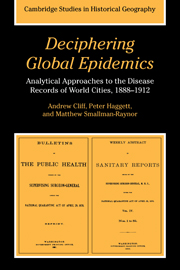 Deciphering Global Epidemics
Deciphering Global Epidemics Book contents
- Frontmatter
- Contents
- List of plates
- List of figures
- List of tables
- Foreword
- Preface
- 1 Prologue: epidemics past
- 2 The nature of the evidence
- 3 The global sample: an overall picture
- 4 Epidemic trends: a global synthesis
- 5 Comparing world regions
- 6 The individual city record
- 7 Epidemics: looking forwards
- Appendices
- A Primary data sources
- B International epidemiological sources
- C National epidemiological sources
- D International and national epidemiological agencies
- Chapter notes
- References
- Index
- Cambridge Studies in Historical Geography
B - International epidemiological sources
Published online by Cambridge University Press: 06 July 2010
- Frontmatter
- Contents
- List of plates
- List of figures
- List of tables
- Foreword
- Preface
- 1 Prologue: epidemics past
- 2 The nature of the evidence
- 3 The global sample: an overall picture
- 4 Epidemic trends: a global synthesis
- 5 Comparing world regions
- 6 The individual city record
- 7 Epidemics: looking forwards
- Appendices
- A Primary data sources
- B International epidemiological sources
- C National epidemiological sources
- D International and national epidemiological agencies
- Chapter notes
- References
- Index
- Cambridge Studies in Historical Geography
Summary
The systematic international recording of information about mortality and morbidity from disease begins with the Health Section of the League of Nations established in the aftermath of the Great War. To promote comparability of recording between nations, the International Classification of Diseases (ICD) has been developed. The origins of this classification system are discussed in Benjamin (1968, pp. 8–86). The first edition of the ICD list was prepared by the International Statistical Institute, and it appeared in 1911 under the title International List of Causes of Death. Revisions have appeared roughly decennially to keep abreast of advances in medical science. The tenth edition (1992) is currently used. Initially, the list formed a basis for the recording of mortality data alone, but it was extended to cover morbidity from 1948 when responsibility for revision of the list was passed from the International Statistical Institute to the World Health Organization. From that date, the ICD list has been entitled International Statistical Classification of Disease, Injuries, and Causes of Death.
The following list gives the major sources of international epidemiological data and associated information. It is arranged historically.
League of Nations
The first meeting of the Health Committee of the Health Section of the League of Nations took place in August 1921 to consider ‘the question of organising means of more rapid interchange of epidemiological information’. To meet this need, a series of publications were instituted and are described below.
- Type
- Chapter
- Information
- Deciphering Global EpidemicsAnalytical Approaches to the Disease Records of World Cities, 1888–1912, pp. 389 - 395Publisher: Cambridge University PressPrint publication year: 1998
